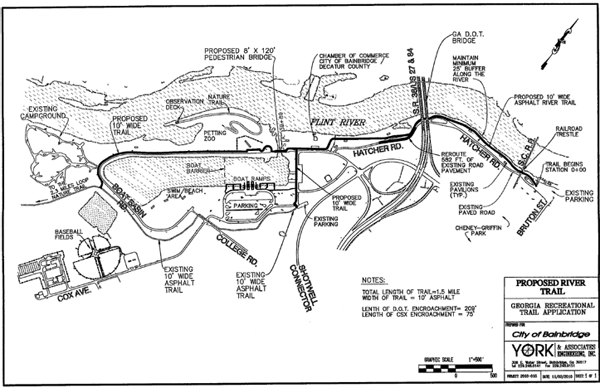City receives $100,000
Published 5:26 pm Thursday, April 14, 2011
The City of Bainbridge was one of 25 governmental agencies that received money to assist with the construction and maintenance of trails and trailheads throughout Georgia.
Bainbridge received $100,000—of a total of $2.1 million distributed by the state—toward the construction of the river walk.
The river walk, which is one of the beginning steps toward completing the city’s waterfront connectivity master plan, will cost an estimated $600,000, with about $200,000 more contributed from the city in terms of its labor, said City Manager Chris Hobby.
“I’m excited about it,” Hobby said Friday. “I think the public is going to like it too.”
The trail will begin at the old train trestle near Cheney Griffin Park, continue southwest along the river side of Hatcher Road, turn onto Boat Basin Circle and go past the Chamber of Commerce building. A suspension bridge will be built over the narrow river channel in the Boat Basin and the trail will continue past the old locomotive to the fenced-in animal area. There, the trail will turn left and connect with the existing nature trail.
The river walk could be used by people walking, running or using a non-motorized vehicle such as a bicycle, said Dustin Dowdy, assistant to the city manager. Benches, light fixtures and fishing piers would be placed along the trail, he said. A playground could be put in at Cheney Griffin Park in the future, Dowdy said.
Hobby said they are looking at various materials to construct the river walk.
For example, when he and others from the city were on the Washington Mall in Washington, D.C., its walkways were made with crushed river rock. Some of the factors the city is looking at are the occasional flooding of the area along Hatcher Road and the root damage that arises in paving. Hobby said the nature trail is an example of how roots may damage the river walk. He also wanted to ensure the material is not physically harsh for those who will use the river walk for exercise.
Hobby said the river walk will be one of the first steps and one of the keys in moving toward connecting downtown Bainbridge to its recreation centers—the Earle May Boat Basin and the Bill Reynolds sports complexes.
He anticipates construction may begin as early as this summer.
Other major components of the connectivity master plan are to redevelop Cheney Griffin Park.
“There will be a major emphasis on Cheney Griffin Park; make it an actual park and not just a parking lot,” Hobby said. Among some of the proposed enhancements at Cheney Griffin Park are a central fountain, day marina and skate park, as well as the beginning of the river walk.
Hobby said also that with the changes planned for Cheney Griffin Park, Hatcher Road will be reconfigured. Although it will still allow for traffic, vehicles won’t be able to park at the river bank as they can now.
Other long-term elements of the master waterfront plan are to correct the sloping of the lawn next to the Bainbridge Performing Arts Building and eventually moving the aquatic center to the boat basin area.
The Bainbridge City Council also hired in March the Ferguson Group from Washington, D.C., toward the goal of garnering federal government money to help with the waterfront master plan. An initial six-month contract with the Ferguson Group is $6,000 per month, or $36,000 total.
Funding for the $100,000 grant comes from the Federal Highway Administration and was appropriated in the 2005 Safe, Accountable, Flexible, Efficient Transportation Equity Act: A Legacy for Users (SAFETEA-LU). The Georgia Department of Natural Resources administers the grant program.
Every recipient is required to match the grant by providing at least 20 percent of the cost of the project.


